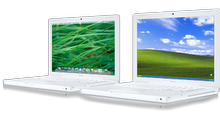MacBook Air is ultrathin, ultraportable, and ultra unlike anything else. But you don’t lose inches and pounds overnight. It’s the result of rethinking conventions. Of multiple wireless innovations. And of breakthrough design. With MacBook Air, mobile computing suddenly has a new standard.

MacBook Air is nearly as thin as your index finger. Practically every detail that could be streamlined has been. Yet it still has a 13.3-inch widescreen LED display, full-size keyboard, and large multi-touch trackpad. It’s incomparably portable without the usual ultraportable screen and keyboard compromises.
The incredible thinness of MacBook Air is the result of numerous size- and weight-shaving innovations. From a slimmer hard drive to strategically hidden I/O ports to a lower-profile battery, everything has been considered and reconsidered with thinness in mind.










 Create Stacks from anything you want to access quickly from one place: a handful of documents, a group of applications, an entire folder. Files you download in Safari or save from an email are automatically directed to a Stack in the Dock, and when the download is complete, the Stack signals that a new item has arrived. When you want to see the files in a Stack, all you have to do is click — Stacks spring open from the Dock in an elegant arc for a few items, or in an at-a-glance grid for more. Pretty neat
Create Stacks from anything you want to access quickly from one place: a handful of documents, a group of applications, an entire folder. Files you download in Safari or save from an email are automatically directed to a Stack in the Dock, and when the download is complete, the Stack signals that a new item has arrived. When you want to see the files in a Stack, all you have to do is click — Stacks spring open from the Dock in an elegant arc for a few items, or in an at-a-glance grid for more. Pretty neat




